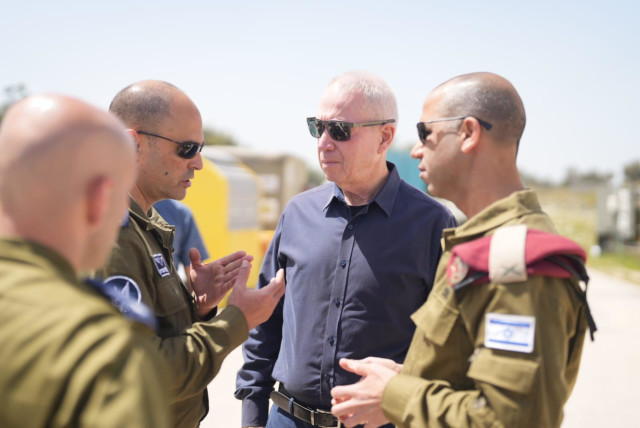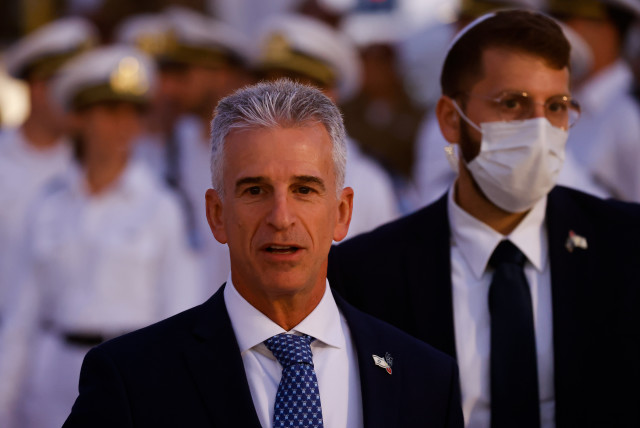What is Iranian nuclear ‘weaponization’ and why is it decisive? - analysis
In the last few decades, there was a battle to stop Tehran from being able to develop a nuclear weapon.
With all of the extra attention Iran has received in recent days in terms of presenting a growing potential nuclear threat, it is worth reviewing what the Islamic Republic has achieved and what tasks it still would need to accomplish in order to cross the nuclear threshold.
In the last few decades there was a battle to stop Tehran from being able to obtain sufficient quantities of highly enriched uranium to be able to develop a nuclear weapon.
Basically, that battle has been lost.
Already in mid-2021, Iran has enriched significant quantities of uranium up to the 60% level, with a jump to the 90% weaponized uranium level being a task that can be accomplished in a matter of weeks.
Only a few weeks ago, Defense Minister Yoav Gallant said that the ayatollahs now had sufficient uranium at 20% and 60% levels that it could potentially jump to enough weaponized uranium for five nuclear weapons in a matter of weeks.
If so, why isn’t the sky falling? Where are the ultimatums from the US, the West or at least Israel for Iran to turn over its nuclear program materials to international inspectors within a short set period of time or face the consequences?
This is where the real “weaponization” or weapons group issue comes into play.
It is not enough to have weaponized uranium. One cannot simply light a match or drop a grenade on such uranium and expect fireworks.
Rather, there is a very special detonation process that needs to occur to achieve a nuclear detonation.
Moreover, unless the Islamic Republic wants to blow itself up, it needs a delivery mechanism – namely a ballistic missile.
Tehran has had ballistic missiles with conventional warheads for decades.
But it has not yet mastered miniaturizing a nuclear warhead to be deliverable on any of those missiles.
For years, at least portions of Israeli and US intelligence had said that Iran was around two years away from mastering these various detonation and delivery skills.
In November 2022, the Jerusalem Post reported exclusively that, remarkably and despite all of Iran’s achievements in various areas, Israel’s two-year basic estimate had remained unchanged.
In 2018, the Mossad seized Iran’s nuclear archives, bringing to light massive amounts of new information about its experiments with nuclear weapons development and some of its more recent activities in that regard.
However, since then, a consistent line of Israeli defense officials have said that the Islamic Republic has not progressed in a way that shortened the two-year gap.
This is surprising in some ways because Tehran has continued to experiment with ballistic missiles and satellite launches nonstop – something which intelligence officials in both the US and Israel agree could advance nuclear weapons delivery capabilities.
In addition, some nuclear experts have speculated that Iran may have covert groups working on these other nuclear skills which the Mossad and CIA have not caught on to.
What are some of the weapons groups activities which need to be undertaken to achieve detonation?
There are at least three items.
One would be the Islamic Republic’s “maintaining the capability to use computer codes to simulate a nuclear weapons explosion. Greater use of simulations would make component testing less necessary.”
A second, according to the Institute for Science and International Security (the good ISIS) would be “retaining a mastery of the multi-point initiation system, e.g., the shock wave generator, including possibly having conducted a successful ‘cold test’ of a nuclear explosive with a surrogate nuclear core.”
In May 2019, a report by the good ISIS described some of what was revealed in the Iranian Nuclear Archive, explaining that a shock wave generator “has the purpose of uniformly initiating a spherical shell of high explosives, or the ‘main charge,’ which in turn compresses the nuclear core made from weapon-grade uranium to achieve a supercritical mass for a nuclear explosion.”
The third item would be “having the capability to make the neutron initiator.”
Another ISIS report in May 2019 said that “Iran planned on using a relatively sophisticated neutron source, or initiator, to trigger a chain reaction in the weapon-grade uranium core of its nuclear weapons.”
A different estimate was given in 2021 by former IDF intelligence chief Amos Yadlin and former Israel Atomic Energy Official Ephraim Asculai in an Institute for National Strategic Studies paper.
Ultimately, they recommend a position that the Islamic Republic would be three to seven months from a nuclear bomb if it finished weaponizing its uranium, but their in-depth explanation of the variables is just as important as their conclusion.
US intelligence believes that these so-called weaponization activities stopped in 2003 and that it would take the Islamic Republic at least 18 months to accomplish them, in addition to additional time for uranium enrichment.
Within this calculation are the variables of safety, how quickly Iran could revamp its weaponization program and to what extent it has covert facilities that could carry out weaponization tests without Israeli and Western intelligence knowing.
The Yadlin-Asculai position was that Iran did not finish all of the weaponization activities before halting in 2003, but did finish many of them, carefully recorded the results and will not need to go back to anywhere near square one.
For example, one of the May 2019 ISIS reports said that major experiments relating to detonation were performed starting in February 2003 in the Taleghan chamber at the Parchin nuclear facility.
Furthermore, the report said that “the work on the neutron initiator does not appear to have been completed on schedule, but continued in the reoriented nuclear weapons program that may continue into the present.”
Measuring the neutrons being emitted is both incredibly difficult and critical.
No one knows how far along Iran got in its measurements of the neutrons, and that is only one weaponization issue.
Debates continue about how much of a covert program Tehran has maintained.
The Mossad helped discover three nuclear sites that the International Atomic Energy Agency (IAEA) did not know about: Turquzabad, Mariwan-Abadeh and another one near Tehran.
Are there more that even the Mossad might have missed?
This is a crucial variable because if there are covert sites, Iran could perform weaponization tests and enrich uranium in parallel instead of waiting to start weaponization until it finishes enriching the uranium and announces it is breaking out to a bomb.
Most estimates assume that Iran will forgo many of the Western-style safety measures if it is rushing out to a nuclear weapon, so the time that such measures would take are often mostly discounted.
The Yadlin-Asculai estimate of three to seven months for other weaponization tasks after any enriched uranium would be weaponized also assumes some disparate activities could be done in parallel.
No one knows the full answer to how long weapons groups’ activities would take Iran, but former IDF intelligence chief Tamir Hayman told the Post in January that Israel could stay ahead of the curve on the issue by carefully monitoring Iran’s senior atomic energy officials.
Contrary to the idea that any movement would need to start with a loud and resonating decision from Iran Supreme Leader Ayatollah Ali Khamenei, Hayman was suggesting that Iranian atomic professionals might at some point start a more bottom-up process.
Whatever the correct estimate is, Israeli intelligence surveillance will remain as important as ever.
Jerusalem Post Store
`; document.getElementById("linkPremium").innerHTML = cont; var divWithLink = document.getElementById("premium-link"); if (divWithLink !== null && divWithLink !== 'undefined') { divWithLink.style.border = "solid 1px #cb0f3e"; divWithLink.style.textAlign = "center"; divWithLink.style.marginBottom = "15px"; divWithLink.style.marginTop = "15px"; divWithLink.style.width = "100%"; divWithLink.style.backgroundColor = "#122952"; divWithLink.style.color = "#ffffff"; divWithLink.style.lineHeight = "1.5"; } } (function (v, i) { });


